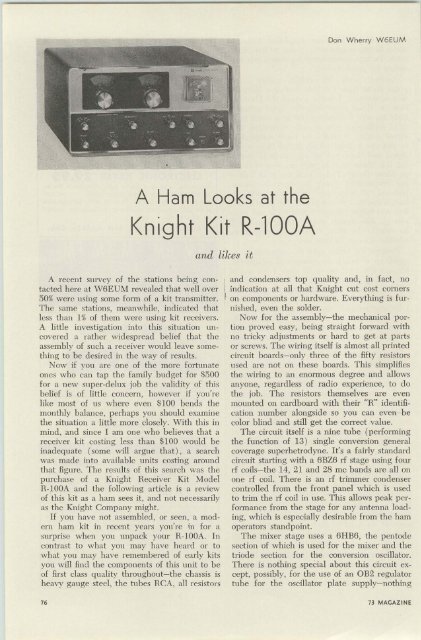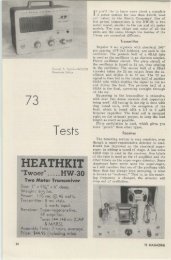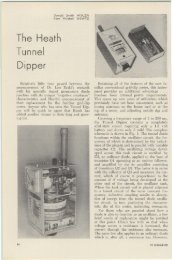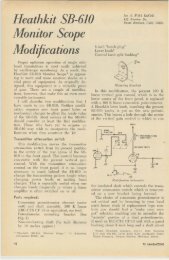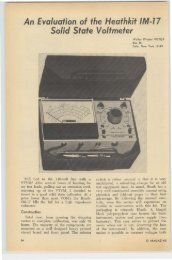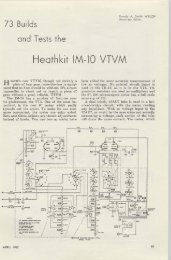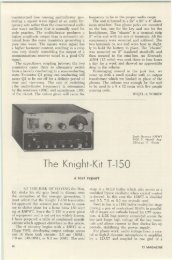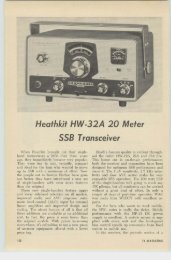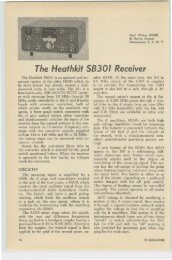Knight-Kit R-100A - Nostalgic Kits Central
Knight-Kit R-100A - Nostalgic Kits Central
Knight-Kit R-100A - Nostalgic Kits Central
You also want an ePaper? Increase the reach of your titles
YUMPU automatically turns print PDFs into web optimized ePapers that Google loves.
Don W he rry W6EUM•A Ham Looks at the<strong>Knight</strong> <strong>Kit</strong> R-l00Aand likes itA recent survey of the stations being contactedhere at \V6EU11 revealed that well over50% were using some form of a kit transmitter.The same stations, meanwhile, indicated thatless than 1% of them were using kit receivers.A little investigation into this situation un covered a rather widespread belief that theassembly of such a receiver would leave somethingto be desired in the way of results.Now if you are one of the more fortunat eones who can tap the family budget for $500for a new super-delux job the valid ity of thisbelief is of little concern, however if you'relike most of us where even $100 bends themonthly balance, perhaps you should examinethe situation a little more closely. \ Vith this inmind, and since I am one who believes that areceiver kit costing less than $100 would beinadequate (some will argue that ) , a searchwas made into available units costing aroundthat figure. The results of this search was thepurchase of a <strong>Knight</strong> Receiver <strong>Kit</strong> ModelR-I00A and the following article is a reviewof this kit as a ham sees it, and not necessarilyas the <strong>Knight</strong> Company might.If you have not assembled, or seen, a modernham kit in recent years you're in for asurprise when you unpack you r H-I00A. Incontrast to what you may have heard or towhat you may have remembered of early kitsyou will find the components of this uuit to beof fi rst class quality throughout-the chassis isheavy gauge steel, the tubes RCA, all resistorsi\and condensers top quality and, in fact, noindication at all that <strong>Knight</strong> cut cost comerson components or hardware. Everything is furnished,even the solder.Now for the assembly- the mechanical portionproved easy, being straight forward withno tricky adjustments or hard to get at partsor screws. The wiring itself is almost all printedcircuit boards- only three of the fifty resistorsused are not on these boards. This simplifiesthe wiring to an enormous degree and allowsanyone, regardless of rad io experience, to dothe job. The resistors themselves are evenmounted on cardboard with their "R" identificationnumber alongside so you can even becolor blind and still get the correct value.T he circuit itself is a nine tube (performingthe function of 13 ) single conversion generalcoverage superhetrodyne. It's a fairly standardcircuit starting with a 6BZ6 If stage using fourrf coils-the 14, 21 and 28 me bands are all onone rf coil. There is an If trimmer condensercontrolled from the front panel which is usedto trim the rf coil in use. This allows peak perfonnancefrom the stage for any antenna loading,which is especially desirable from the hamoperators standpoint.The mixer stage uses a 6 HB6, the pentaclesection of which is used for the mixer and thetriode section for the conversion oscillator.There is nothing special about this circuit except,possibl y, for the use of an OB2 regulatortube for the oscillator plate supply-nothing7673 MACAZINE
else is on this regulator tube.One thing about the circuit so far whichdoes deserve mention is the band switch. Thisswitch is a printed circuit hoard type and isthe greatest thing invented since suspend ers.It simp ly plugs into the main board and is soldered in place- 36 connections made in app roximatelytwo minutes ,vith no possibility of amistake. The two if stages use the pentode sectionof two 6AZ8 tubes and are nothing unusual.The d emodulator (detector) uses onesection of a triple diode 6BC7 in a typicaldiode d etector circuit. The second diode ofthis tube is a AVC rectifier which has a builtin delay to remove all AVC action on weaksignals. The third section is a series noiselimiter which automatically ad justs itself forthe average level of the received signal. Thisworks real well for ham use. The two stageaudio section is entirely normal and needs nocomment. The BFa uses the triode section of a6A'V8 and is unusual in that the BFO outputsignal is fed into the circuit at the input to thesecond if stage, and there at a very low level.This seems to allow better operation on SSBand, when this feature is combined with thereal smooth vernier action of the BFO frequency control, it allows excellent SSB reception.This fro m what is normally consid eredall AM detcctor-SSIl is AM by the way. Aproduct detector would probably operate alittle better hut this circuit does d o a goodjob.The Q multiplier is really something. Somemultipliers of this type seem to be unstableand hard to operate when used in the "peak"mode, but this receiver seems to have lickedthe problems and its u se makes a world ofd ifference when you are trying to beat somebad QRM-and who isn't? Fact is if you havenever operated one of these little jobs youwill be amazed at the way you can pull a signalout from a big pileup of QRM. It's also valuableas a null device but, in my opinion, it isnot as fine a performer there as a notch filter.Nothing else about the circuit is unusualenough to mention except that the power supplyfilter uses an LC comb ina tion instead ofthe more common RC, with the result thatthere is no discernible hum at all in the output.A check on the sensitivity indicated that thespecifications were reasonably close. Howeveryou must expect to do an alignment job to getreal good results. Kni ght has complete alignmentinstructions and even suggests a way todo the job without a signal generator. H oweverI would strongly recommend the use ofa good rf signal generator. The roils are allpre-aligned but, that is not good enough if youwant top results. T he AVC does not operateon C' V or SSB. This, in my opinion, is notespeciall y important and only means tha t youmust lise the rf gain control for a volumecontrol when in those modes.The ove rall construction of this kit was sostrnlght-forwnrd and easy that no special instructionsto you, as the builder, seem necessary.Just th e usual caution to "do it theirway." Use th e manual and follow directionsand you can't go wrong. The only troubleyou might experience is in the identification ofsome things such as switches, controls, e tc.,and even there you will find, somewhere onthe p ictorials. the information you want.Xow for a few general comments on thislittle job. The rig is much better looking thanthe pictures would indicate, the combinationof jet b lack, silver and gray is real nice. Whenused with its matching t ransmitter it makesa very nice looking sta tion. [ do think, however,that the average ham will deplore thefact that it is not a "hambands only" receiver.While the banclspread feature spreads thebands over approximately 165 degrees of thebandsp rcad dial, the markings a re not especiallyeasy to read . T hey look a little crowded.Also the ha ndsp read d ial has a ratio of aboutsix to one in reduction and that also wouldhe better if it were 12 or 15 to one. It's nothard to tUIIC as is, but any help along thatline is desirable. Maybe if enough of youwould write <strong>Knight</strong> they would put out a hamband on ly model of this same receiver wherea better dial a nd tnning ratio could b e used.Since this is a general coverage type receive ryou should purchase the 100 kc calibrationaccessory, which is available quite reasonably.T his I feel is important and just might saveyou a p ink ticket. The S meter accessorymakes the outfit look much nicer but addsnothing to the actual operation .There is no more than the normal amountof drift in the conve rsion oscillator as it warmsup. a nd after a few minutes this settles downwell. Xo drift in the BFa was noticeable. Aremote connection is brought out on the rearof the chassis to silence the receiver while youare on transmit and it works well.To summa rize- I think that the only conclusionthat can be drawn is-if you have severalhundred d ollars to spend, go ahead and buya SX1l5 or the Svline, but if not, take a goodlook at this kit receiver. If you want a generalco ve rage job I d oubt if you can touch abetter receiver for the S100 asked.W6EU~ [JU LY 196377


